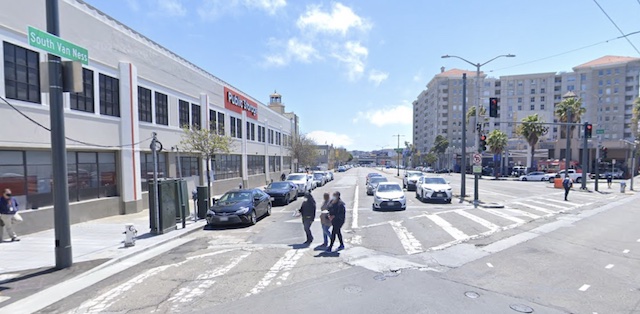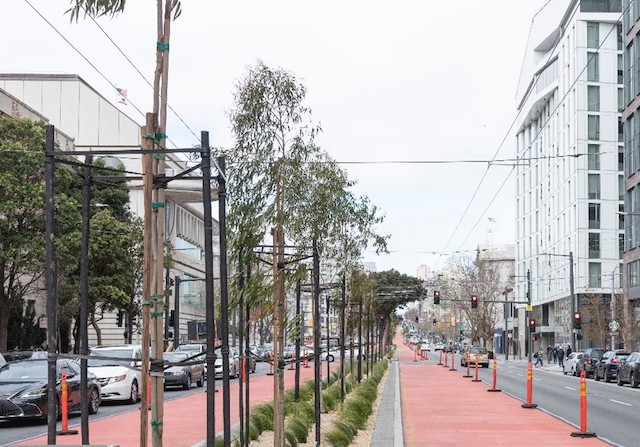Ten years ago, the San Francisco Municipal Transportation Agency (Muni) decided to build a two-mile long busway on Van Ness Avenue, dedicating two lanes of the six-lane street exclusively to buses. The project was supposed to cost $125.6 million and make transit more attractive by speeding up buses. The planners’ calculations indicated that, without the project, buses would carry 50,800 transit riders a day. With the project, it would carry 52,400 riders, a 3.15 percent increase.
Van Ness before the busway. Click on image to see the original photo in Google street view.
The busway opened for business last week after more than a decade of planning and six years of construction. The final cost turned out to be $345.9 million, a mere 175 percent cost overrun. Ridership on Muni buses is currently about half what it was before the pandemic, and it will be a long time before the Van Ness route recovers to 50,800 riders a day, much less 52,400.
Van Ness today. Note the traffic jam on the left, made worse by the loss of a traffic lane.
Since this is just two miles long, the average cost was $173 million per mile. That would have been considered unthinkably expensive for light rail a couple of decades ago. The idea that mere bus lanes should cost that much is ridiculous.
In related news, San Francisco’s Third Avenue light-rail project, also known as the Central Subway, is supposed to open in September. But a recent FTA report suggests that it may not open until early 2023.
This project can be traced back to at least 1998, when it was supposed to be a 5.6-mile extension of San Francisco’s light-rail system costing $446 million that was predicted to carry more than 80,000 riders a day — though all but 2,000 of them would have been riding transit even without the project.
Costs grew and the project was cut back until now it i just 1.7 miles long costing more than $1.9 billion. Nor is the most recent delay unusual, as when it was fully funded the project was expected to open in 2018 — a 333 percent cost-overrun for a smaller project. Naturally, no one thinks it will carry 80,000 riders a day; the most-recent estimate I’ve seen is 35,000 a day, nearly all of whom would have ridden transit without it.
These are just two more examples of why Congress should have repealed the New Starts/Small Starts program. Instead, as I described in yesterday’s policy brief, it expanded it, which means we’ll see a lot more pointless busways and rail transit projects in the next five years.










50,000 riders a day sounds impressive….
Put another way
50,000 divided by a 40 passenger bus is 1250 buses a day, averaging peak rush hour and return. San Fran didn’t need federal money for bus runs….They could have had hired private bus contractor.
How has the project affected auto traffic? In my experience most planners hate cars and resent the fact they are so convenient that they are used much more heavily than transit. Therefore, they try to make it difficult to drive by restricting parking, decreasing traffic lanes to increase auto travel times. If by taking away a couple of lanes traffic causes travel times by auto to increase, some planners may well consider this project a success.
Metro Transit wants to spend more than half a billion, ya, $500,000,000+ on what it’s called the purple line.
90% of it’s paltry ridership will occurring on the southern 2/3 of the line between Maplewood Mall and downtown ST Paul. The last 1/3 of the line to White Bear Lake isn’t wanted by the city. Worse, there’s little to nothing on the corridor to serve; it’s suburbia after all.
They speculate than in a generation, in 2040, they may see 7,000 rides – ~3,500 people – using it each day.
They could cut the cost of the project by 30% and end it at St. John’s hospital. They’ll still server 90% of the few riders they may have.
But they won’t.
They have other people’s money to spend in the name transit equity.
The most frightening thing about the article is the Google street view with all the sheeple wearing masks outdoors.